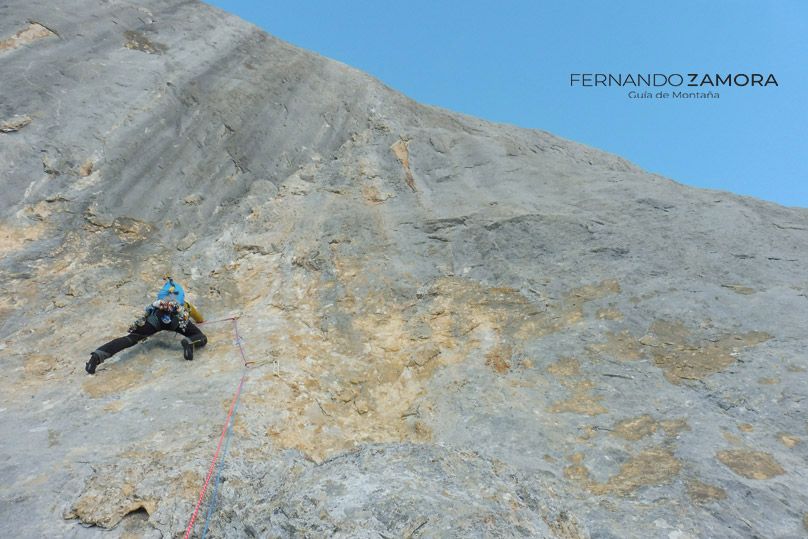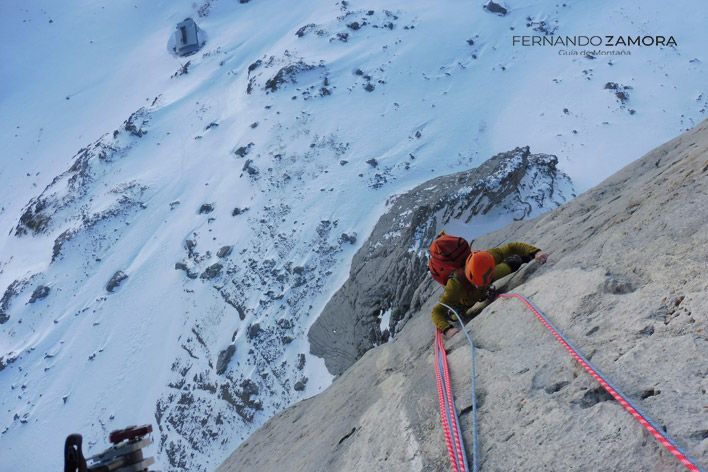The Murciana 78 in the Naranjo de Bulnes (Picu Urriellu) is one of the most repeated routes in the West Face. As shown in the topo, the Murciana runs through the centre of the wall quite directly.
The rock quality is very good overall and the atmosphere attractive. Many of its pitches exceed 45 m and crosses large walls of holes which are amazing to climb.
Even if the hardest pitches are fairly well-equipped, the rest of the route is rather sparsely equipped, so it's wise to feel confident in grade V.
All the belay stations are set up using bolts with rings which makes the retreat easy.
Murciana 78 in the Naranjo de Bulnes (Picu Urriellu). Route description:
- First pitch : at the bottom of the route we'll see a large flake forming a kind of chimney. Even if it's possible to climb it up, the route starts on the left side through a sort of dihedral-crack which is the most difficult section of the route. Then we continue along an easier section leading to the belay station.
- The second pitch starts traversing to the right, not straight ahead as it may seem, until reaching a very noticeable dihedral along which we continue up to the belay station.
- Third pitch : we arrive at the overhang. Well-equipped with bolts, most of the pitch can be climbed in A0, except for a section in 6b which requires friends to be installed.
- The fourth pitch : well-equipped with bolts and some obligatory move in the last bolts.
- The beginning of the fifth pitch has some bolts which guide us along the way, then the anchors are getting distant from each other, but the terrain becomes easier. The rock of this pitch and the two next ones is exceptional.
- The sixth pitch crosses walls of perfect rock holes, little difficulty but few anchors. The belay station is located on a comfortable ledge. At this point the two most classic routes of the West Face of the Naranjo de Bulnes meet, the Murciana and the Rabadá Navarro.
- The seventh pitch : beautiful, it gains verticality again by climbing an impressive wall of holes. Don't dismiss opportunities to place protection.
- The eighth pitch changes completely and follows a system of dihedrals.
- The ninth pitch consists of a kind of ascending ledge towards the right. At the end don't continue straight on as it may seem, but continue one more section in an ascending traverse to the right until you find another better marked dihedral (a piton) and at the end, make a traverse to the left protected with a bolt that will lead you to the belay station just below the Laja España (Spain Flake).
- We reach the tenth pitch, the Laja España : it's not very difficult, but the rock isn't so good.
- The eleventh pitch leaves the belay station via a large wall of very good rock holes. Two rock tunnels can be spotted above the belay station but hey don't belong to the route (typical misunderstanding). Then you'll need to climb a slightly ascending traverse to the right up to a bolt, hard to spot and located about 10-15 m on the right, there aren't many anchors which can make it difficult to orientate oneself. The belay station stands more or less vertically above the previous one.
- Finally, in the last pitch, we have to climb towards a small crack or depression that can be seen above the belay station on the left. At the end of this crack, we can set up a belay using pitons or, even better, on a ledge a bit higher up. It's also possible to continue to the right (a few meters of simul climbing) along a dihedral, which ends on some ledges where it's easy to set up a belay station using friends. From here we reach the summit walking.
- We get back down using the rappels that have been set up in the South Face. Traditionally, people used to rappel down the Directa de los Martínez, but two parallel lines have recently been installed to avoid gatherings as well as disturbing people climbing the Directa de los Martínez (see descent description).
To sum up, the Murciana in the Naranjo de Bulnes (Picu Urriellu) is an exceptional route that may be among the best in its style in our country. Highly recommended.
FACT SHEET
LENGTH
DIFFICULTY
DURATION
EQUIPMENT
DESCENT
FIRST ASCENT









